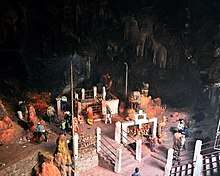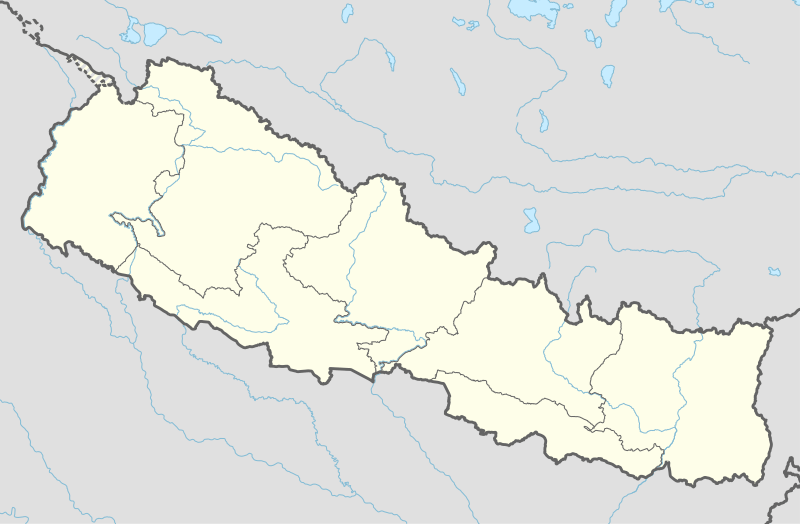Halesi-Maratika Caves
The Halesi-Maratika Caves (also the Haleshi Mahadev temple) are located next to the village of Mahadevasthan, in the Khotang District of eastern Nepal, 3,100 ft. – 4,734 ft. above sea level. The cave and temple are about 185 km south west of Mount Everest. The temple is a venerated pilgrimage site for Hindus and Buddhists. The caves are called the Halesi Mahadev Temple by Hindus who associate them with Mahadeva, a form of Shiva;also it is known as The Pashupatinath of East (पुर्वको पशुपतीनाथ) all over the country and Buddhist, who consider them to be the caves associated with the legend of Padmasambhava. This caves host various ceremonies and celebration, specially various मेला On the occasion of Mahashivaratri, Chaturthi etc and it is an excellent example of religious tolerace existing in the country.[1]
| Halesi-Maraktika Caves | |
|---|---|
Haleshi Mahadevstan | |
 The main Halesi-Maratika Cave (Halesi Mahadev Temple) | |
| Religion | |
| Affiliation | Hinduism |
| Province | Province 1, Khotang |
| Deity | Mahadev |
| Location | |
| Location | Rupakot-Majuwagadi Municipality |
| Country | Nepal |
 Halesi-Maraktika caves in Nepal | |
| Geographic coordinates | 27.19006°N 86.622391°E |
| Architecture | |
| Type | naturally formed |
Geology and environment
This cave is 67 feet below the surface. It is a tourist destination. Its entrance is shaped as a half moon and faces towards the east. It has a round shape, with a diameter of 193 feet, with another, separate, cave lying beneath. The floor is 223 feet in circumference.[2][3] The location of this cave lies between the holy rivers Dudh Koshi and Sun Kosi. This place is usually cold and rainy. Nowadays it is accessible by motorcycles and jeeps.
History
The caves of Halesi-Maratika are referred to in Himalayan literature as far back as the 12th century. Kathang Zanglingma, a biography of Padmasambhava, a terma revealed and transmitted by Nyangrel Nyima Ozer, describes the original events which made the Maratika caves a sacred place for Vajrayana practitioners.[4]
Religious significance
.jpg)
The most famous natural cave in Khotang District is said to have been the abode of Mahadeva while hiding away from the monster Bhasmasur. It is an important pilgrimage centre located in east Nepal for both Hindus and Buddhist. The cave is nicknamed 'the Pashupatinath of the east'. Well attended religious fairs are observed here on Shivaratri and Bala Chaturdashi.[5]
In Buddhism
Mandarava and Padmasambhava realised a number of terma that had been elementally encoded in the cave by Dakini Sangwa Yeshe. These terma number among the longevity teachings of Buddha Amitabha, and were given at the behest of Bodhisattva Avalokiteswara. It is here, at the cave, that Mandarava and Padmasambhava attained the Vidyadhara of longevity (or long life).
In Hinduism
Hindus from India come to visit here after climbing many hills. Many people come here from places like Ladania and Jayanagar during the month of Shrawan to pray to Haleshi Mahadev. It is believed that Lord Shiva hid from the demon Bhasmasur for 6,000 years in this cave. During the holidays of Bhasmasur, Rama Navami[6] and Ganesh Chaturthi, fairs and festivities are held in the area.
References
- "Maratika cave".
- "Halesi Tour".
- "Haleshi Mahadeva or Maratika Cave". Archived from the original on 2016-10-15. Retrieved 2010-10-19.
- Buffetrille, Katia (1994). The Halase-Maratika Caves (Eastern Nepal): A sacred place claimed by both Hindus and Buddhists. Pondy Papers in Social Sciences. 16. Pondicherry: Institut Français de Pondicherry.
- Buffetrille, Katia (2012). "Low Tricks and High Stakes Surrounding a Holy Place in Eastern Nepal: The Halesi-Māratika Caves". In Buffetrille, Katia (ed.). Revisiting Rituals in a Changing Tibetan World. Brill's Tibetan Studies Library. 31. Leiden / Boston: Brill. pp. 163–208. ISBN 9789004232174. ISSN 1568-6183.
- "Devotees throng Halesi on Ram Nawami". Republica. Archived from the original on 4 March 2016. Retrieved 8 April 2014.
| Wikimedia Commons has media related to Halesi ~ Maratika caves. |